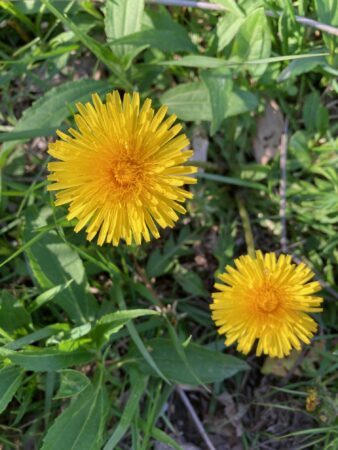Taraxacum officinale. This is the scientific name of the common dandelion. The dandelion is in the plant family Asteraceae.
Dandelions are herbaceous perennials. This means they die down to the ground level after every growing season, but return in the following season via their root-stock.


Roots
Dandelions grow from a taproot, a large root that grows downward and acts as a center for other roots to grow laterally. Taproots are often difficult to uproot/transplant. There are 3 main shapes taproots can be: carrot-shaped, radish-shaped, and turnip-shaped. Dandelion roots are generally carrot-shaped.
Leaves and Stems
Dandelion stems grow from the taproot. The plant can have one singular stem, or several stems growing from the same root. Stems can be upright or lax (along the ground). Dandelion stems can be tinted purple or green and are sometimes covered in tiny hairs. The stems are hallow and when torn they produce a sticky sap. Each stem produces a single flower head.
Dandelion leaves are basal. This means leaves also grow from the base of the plant at the ground and attach in the same place as the stems. Leaves can be oblanceolate (pointed end at the base), oblong (elongated with parallel sides), or obovate (teardrop shape). Leaves are lobed, lacerate (jagged), and toothed with sharp or dull teeth.
Flowers
As we said, each stem has its own flower. Dandelion flowers are considered “heads”, which means they are composed of many tiny florets (between 40 to over 100 florets per head). The flower heads are yellow and ligulate (rays). There are greenish or purplish calyculi, cup like bracts that hold up the florets, which are composed of 12 to 19 segments.
Fruits and Seeds
Each of the dandelion florets matures into a fruit called an achene and are green or brown colored. They are oblanceolate and 2-3mm long. The fruits are attached to pappi which are silvery white and form the “parachutes” to help transport seeds. Most of us are familiar with the childhood tradition of making a wish, blowing on these pappi and watching them fly through the air.
Dandelion Uses
The entire dandelion plant is edible. Leaves are best when picked before the plant flowers as this is when they will be the least bitter, although some bitterness is difficult to avoid. Dandelion greens are a great source of vitamins and minerals. Flowers can be picked at any time and eaten raw or cooked. Dandelion roots are also edible and can be used to make tea.

Hopefully you enjoyed learning a bit about the taxonomy of dandelions! To learn more about the basics of plant taxonomy in general, check out this blog.


Comments
One response to “Plant Profile: All About Dandelions”
[…] If you enjoyed this plant profile on violets, check out the last plant profile on dandelions. […]